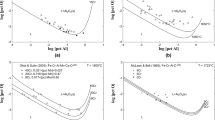Abstract
The joint complex deoxidation of carbon steel melts is analyzed. A procedure is proposed to calculate the equilibrium oxygen concentration in a melt. Rail steel is used as an example to study the joint complex deoxidation of a melt by aluminum and silicon. Mullite (2Al2O3 · 3SiO2) and kyanite (Al2O3 · SiO2) are considered as the reaction products. Thermodynamic calculations demonstrate that the deoxidizing capacity of aluminum is increased in the presence of silicon in a melt. In this case, a substantial increase in the deoxidizing capacity in the concentration range 0.001–0.1 wt % Al is achieved when kyanite (Al2O3 · SiO2) forms in the reaction products. The results of laboratory and industrial experiments on complex deoxidation are shown to agree well with the calculated data. These results demonstrate that the proposed calculation procedure can be recommended to determine the equilibrium oxygen concentration in a melt in the presence of several deoxidizing elements.
Similar content being viewed by others
References
J. Andersson, “Non-Metallic Inclusions Reduce the Fatigue Strength and Endurance” 1VA Medd. 1(169/1), 100–110 (1971).
S. Kobayashi and H. Nishiumi, “On the Coagulation of Inclusions in Deoxidation with Silicon-Manganese” Tetsu to Hagane 58(6), 685–693 (1972).
N. N. Vlasov, A. I. Monastyrskaya, V. A. Golomazov, and N. A. Deev, “Effect of Nonmetallic Inclusions on the Fatigue Strength of High-Carbon Steel and Fatigue Life of a High-Strength Wire” in Steel and Nonmetallic Inclusions (Metallurgiya, Moscow, 1980), pp. 111–116.
A. A. Deryabin, V. I. Syreishchikova, E. L. Kolosova, et al., “Decrease in the Contamination of Rails by Stitch Oxide Inclusions during the Deoxidation by an FeSiCaVAl Steel by Alloys” Metallurg, No. 12, 20–23 (1980).
V. Ya. Dashevskii, N. N. Makarova, K. V. Grigorovich, and V. I. Kashin, “Complex Deoxidation of Iron-Nickel Melts” Russian Metallurgy (Metally), No. 1, 17–24 (2002).
F. Ishii and S. Ban-ya, “Deoxidation Equilibrium of Silicon in Liquid Nickel and Nickel-Iron Alloys” ISIJ Intern. 32(10), 1091–1096 (1992).
A. V. Velikanov, V. A. Reikhart, I. S. Baulin, et al., “Enhancing of the Requirements for the Metallurgical Quality of Rail Steel to Increase the Resistance of Rails to the Formation of Contact-Fatigue Defects” Vestnik VNIIZhT, No. 8, 50–58 (1978).
J. Manot, J. Y. Cagne, and B. Heritier, “Propriete Inclusionion-Naire et Tenue en Fatique des Aciers pour Raulements” Rev. Met. 93(10), 761–770 (1986).
V. V. Panasyuk, Limiting Equilibrium of Brittle Bodies with Cracks (Naukova Dumka, Kiev, 1968).
Steel at the Boundary of Centuries, Ed. by Yu. S. Karabasov (MISiS, Moscow, 2001).
H. Ohta and H. Suito, “Activities in CaO-SiO2-Al2O3 Slags and Deoxidation Equilibria of Si and Al” Met. Mater. Trans. B 27, 943 (1996).
K. V. Grigorovich, A. S. Trushnikova, A. M. Arsenkin, S. S. Shibaev, and A. K. Garber, “Structure and Metallurgical Quality of Rail Steels Produced by Various Manufacturers” Russian Metallurgy (Metally), No. 5, 427–438 (2006).
L. A. Smirnov, A. A. Deryabin, A. B. Dobuzhskaya, G. A. Galitsyn, and V. I. Syreishchikova, “Works in UIM on Increasing the Quality of Russian Rails” in Nonmetallic Inclusions in Rail Steel (GNTs RF OAO UIM, Yekaterinburg, 2005), pp. 27–40.
O. Wijk and V. Brabie, “The Purity of Ferrosilicon and Its Influence on Inclusion Cleanliness of Steel” ISIJ Intern. 36(36), 132–135 (1996).
Steelmaking Data Sourcebook (Gordon & Breach, New York, 1988).
Yu. P. Snitko, Yu. T. Surovoi, and N. P. Lyakishev, “Relation between the Interaction Parameters and Atomic Characteristics of Components” Dokl. Akad. Nauk SSSR 268(5), 1154–1156 (1983).
A. M. Katsnelson, V. Ya. Dashevskiy, and V. I. Kashin, “Carbon Activity in Fe-, Co-, Ni- and Mn-Based Melts at 1873 K” Steel Research 64, 197–202 (1993).
T. Fujiawa, M. Suzuki, Yo. Wantbe, and H. Sakao, “Equilibrium between Molten Iron and Al2O3-SiO2 Oxides” Tetsu to Hagane 72(2), 46–51 (1986).
I. S. Kulikov, Metal Deoxidation (Metallurgiya, Moscow, 1975).
Author information
Authors and Affiliations
Corresponding author
Additional information
Original Russian Text © K.V. Grigorovich, A.K. Garber, 2011, published in Metally, 2011, No. 5, pp. 171–180.
Rights and permissions
About this article
Cite this article
Grigorovich, K.V., Garber, A.K. Analysis of the complex deoxidation of carbon steel melts. Russ. Metall. 2011, 934–941 (2011). https://doi.org/10.1134/S0036029511090151
Received:
Published:
Issue Date:
DOI: https://doi.org/10.1134/S0036029511090151




